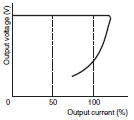Question
What is overload protection function?
Answer
This protection function prevents damage to the Power Supply itself due to overcurrent (including output short-circuits). The protection function is activated and the output current is limited when the load current is greater than the overcurrent detection value (this value depends on the model).
The output voltage will also drop according to the overload (load impedance).
The drop level depends on the overload conditions and load line impedance.
The following table shows the six types of output voltage drop characteristics for main models when the overcurrent protection function is operating.
These drop characteristics can be seen as indicating the limit on the output current that can be supplied to the load effectively in the process in which the output voltage starts when the AC input turns ON. When connecting a load (with built-in DC-DC converter) that starts operating from a low voltage or a capacitive load in which inrush current can flow easily, consider the trend in overcurrent protection drop characteristics and the startup characteristics on the load side when selecting the Power Supply.
Generally, an inverted L voltage drop is considered favorable at startup.
| Overcurrent drop characteristics | Relationship between output voltage and output current | Trend | Main models |
| Gradual current/ voltage drop |  | When a voltage drop occurs, the output current also gradually drops, and the output returns to the normal level automatically (automatic recovery) when the overcurrent status is cleared. | S82K: 3 W, 7.5 W, 15 W S8VS: 15 W |
| Inverted L voltage drop |  | When a voltage drop occurs, the output current remains essentially constant. The output returns to the normal level automatically (automatic recovery) when the overcurrent status is cleared. | S82J: 100 W (5 V, 12 V, 15 V), 150 W, 300 W S82K: 90 W, 100 W S8TS S8T-DCBU-02 S8VS: 240 W S8VM (12, 15, 24 V): 50 W, 100 W, 150 W, 300 W, 600 W, 1,500 W |
| Voltage/ current drop Intermittent operation |  | When a voltage drop occurs, the output current also gradually drops, and the load of the Power Supply itself is reduced (automatic recovery) using intermittent output when the voltage drops to a certain level or lower. | S82J: 10 W, 25 W |
| Inverted L voltage drop Intermittent operation |  | When a voltage drop occurs, the output current remains essentially constant. The load of the Power Supply itself is reduced (automatic recovery) using intermittent output when the voltage drops to a certain level or lower. | S8VS: 30 W, 60 W, 90 W, 120 W, 180 W S8VM (5 V): 50 W, 100 W, 150 W, 300 W, 600 W |
| Gradual current increase/ voltage drop Intermittent operation |  | When a voltage drop occurs, the output current increases as the voltage drops, maintaining constant power, and the load of the Power Supply itself is reduced (automatic recovery) using intermittent output when the voltage drops to a certain level or lower. | S82J: 50 W, 100 W (24 V) S82K: 30 W, 50 W S8VM: 15 W, 30 W |
| Inverted L voltage drop Shut off |  | When a voltage drop occurs, the output current remains essentially constant. If, however, the overcurrent status continues for longer than a fixed time, the output will be interrupted and the power will need to be turned ON again to recover. | S82J: 600W |
Note:
1.Loads with built-in DC-DC converters (Programmable Controllers, digital panel meters and other electronic devices) and capacitive loads are connected, the overcurrent protection function will be activated at startup, which may prevent the Power Supply's output from turning ON.
2.Continuing to use the Power Supply with an output short-circuit or in overcurrent status may cause the internal parts to be deteriorated or damaged.
3.If a load short-circuit occurs, the actual drop in voltage depends on the impedance of the load lines being used.
4.Even if the inclination of the drop characteristics is the same, the actual characteristics (output current/voltage, etc.) depend on the model.
5.Specific precautions apply to some models. For details, refer to the separate information in the datasheet for each model.
Applicable Models: All Models
Recommended Products
Other Power Supplies FAQ
-
 What factors should be considered when selecting Power Supplies?
What factors should be considered when selecting Power Supplies?
-
 The output indicator turns ON, but then turns OFF immediately. What is the cause of the problem and solution (in models equipped with the overvoltage protection function)?
The output indicator turns ON, but then turns OFF immediately. What is the cause of the problem and solution (in models equipped with the overvoltage protection function)?
-
 The output voltage decreased while Power Supplies are in use. What is the cause of the problem and solution?
The output voltage decreased while Power Supplies are in use. What is the cause of the problem and solution?





